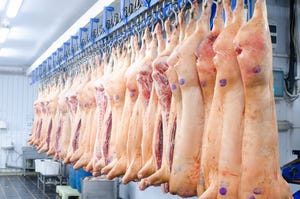Effect of early vs. late maturing sire lines and creep feeding
What is the impact on stress response, intestinal permeability and growth performance of nursery and finishing pigs?
July 13, 2023
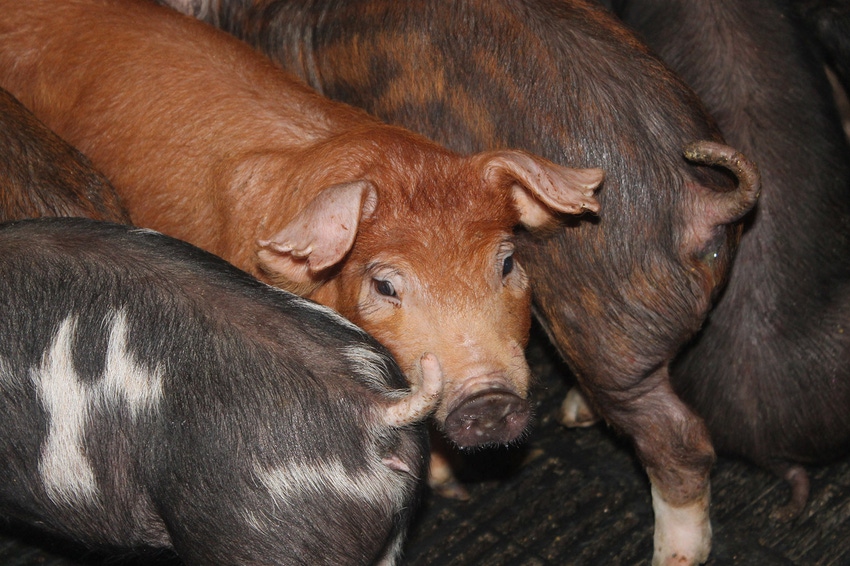
As genetic companies have selected for increased finishing pig performance, getting pigs started on feed after weaning has become more challenging. This suggests that genetics may influence the pig's stress response and subsequent post-weaning performance. While it is well known that different sire lines will influence their progenies' growth performance, limited data are available on the effect of weaning on the stress response and intestinal permeability of early versus late maturing Duroc sire lines.
Providing creep feed during lactation acclimates pigs to solid feed prior to weaning. While creep feed consumption often has little effect on weaning body weight, the true value of creep feed is found in getting pigs started on feed in the nursery. Research consistently shows that pigs identified as eaters of creep feed during lactation have improved feed intake and body weight gain after weaning.
Hence, the primary objective of this study was to determine the effect of sire line growth pattern and creep feeding on the time it takes pigs to begin consuming feed post-weaning, the percentage of pigs that lose weight immediately post-weaning, and the feed intake and growth performance of pigs from weaning to market. The secondary objective of this study was to determine if sire line maturity influenced the stress response and subsequent intestinal barrier integrity of pigs after weaning.
Procedures
Breeding
A total of 30 sows (DNA 241) from the Kansas State University Swine Teaching and Research Center were used to supply the pigs for this experiment. At breeding, sows were blocked by parity (parity 1 and 2+) and every other sow was bred to one of two sources of semen selected from Duroc sires with the highest index of early growth in the nursery, or finishing growth (early or late maturing, respectively). Sows were housed in individual stalls until confirmed pregnant and then were moved to group housing. Throughout gestation, a common gestation diet was fed in meal form, and feed allowance was adjusted based on sow body condition. On approximately day 111 of gestation, sows were moved into the farrowing facility.
Pre-weaning
A total of 21 litters (early or late maturing Duroc × DNA 241) were selected and used for the remainder of the experiment. Pigs within each litter were individually weighed 24 hours after birth and 14 days prior to weaning for creep feed treatment allotment. Litters of pigs were assigned to one of two creep feeding treatments (with or without creep feed) in a randomized complete block design based on sow parity, sire maturity and average piglet body weight. For litters of pigs assigned to the creep feed treatment, a phase 1 nursery diet was fed. The creep diet was pelleted (3/16 × 1/2 in.) and fed using a commercial rotary creep feeder starting 14 d prior to weaning. A common lactation diet was fed to sows throughout lactation in meal form.
Post-weaning
At weaning (approximately 21 d of age), a total of 247 pigs (initially 14.0 lb) were weighed and assigned to 51 pens in a completely randomized design based on Duroc sire line (early or late maturing) and creep feeding treatment (with or without). There were four or five pigs per pen and 12 or 13 replications per treatment combination. Each pen (4 × 4 ft) contained a four-hole, dry self-feeder, and nipple waterer for ad libitum access to feed and water. Pigs were individually weighed on d 3 and 10 post-weaning to determine initial changes in body weight. Feeders were also weighed daily for the first 14 d post-weaning to determine initial feed intake and daily feed disappearance over time. After 14 d, pigs were weighed and feed disappearance measured weekly to determine average daily gain, average daily feed intake and feed-to-gain ratio. Common diets were fed throughout the nursery based on a four-phase feeding program, with phases fed from d 21 to 31, 31 to 46, 46 to 67, and 67 to 76 of age, respectively. Phases 1, 2, and 4 diets were provided in pellet form, and phase 3 diets were in meal form.
At the end of the nursery period, 241 pigs were transported to the finisher facility and gate cut into 32 pens based on Duroc sire line (early or late maturing) and creep feeding treatment (with or without). There were seven or eight pigs per pen and seven or eight replications per treatment combination. Each pen was equipped with a twp-hole, single-sided, dry self-feeder (Farmweld, Teutopolis, Illinois) and a cup waterer. Pens were located over a completely slatted concrete floor with a 4-ft pit underneath for manure storage. A robotic feeding system (FeedPro; Feedlogic Corp., Wahpeton, North Dakota) was used to deliver and record daily feed additions to each pen. Pens of pigs were weighed every other week and feed disappearance was measured to determine growth criteria until market. Common corn-soybean meal-based diets were fed over a three-phase feeding program throughout the finisher in meal form. At the end of the study pigs were tattooed and tagged before being shipped to Triumph Foods in Saint Joseph, Missouri, for carcass measurements.
Blood cortisol and intestinal permeability
Cortisol concentrations in blood serum were used to determine if sire line maturity influenced the short-term stress response of pigs immediately after weaning. The day prior to weaning, one or two gilts per litter (28 gilts total) were randomly selected to determine baseline cortisol levels. The following day, 30 minutes post-weaning, the same gilts were bled to determine changes in blood cortisol due to weaning stress. One blood sample of approximately 6 mL was collected on each collection day. Serum was then separated by centrifugation (20 min at 10,000 × g) and stored at -4°F until analysis using a commercial ELISA kit (R&D Systems, Minneapolis).
The same subset of gilts used for cortisol concentrations were used to measure intestinal permeability to a disaccharide and monosaccharide via blood concentrations of lactulose and mannitol. Gilts used for intestinal permeability analysis were weighed and moved to empty pens with access to ad libitum water, but no feed. After a 2-h fast, each gilt was administered a solution of lactulose (500 mg/kg body weight; Fisher Scientific, Pittsburgh) and mannitol (50 mg/kg body weight; Sigma-Aldrich, St. Louis, Missouri), dissolved in distilled water via oral gavage. Sixty minutes following sugar administration, a blood sample of approximately 6 mL was collected from each gilt. Following collection, serum was separated by centrifugation (20 min at 10,000 × g) and stored at -4°F until samples were sent to the University of Illinois for high performance liquid chromatography analysis of lactulose and mannitol concentrations. The lactulose:mannitol ratio (L:M) was calculated by converting lactulose and mannitol concentrations to umol/L using the molecular weight of each sugar, and then calculating their ratio.
Data analysis
Nursery and finishing pig growth performance data were analyzed as a 2x2 factorial to test the interactive and main effects of Duroc sire line (early or late maturing) and creep feeding (with or without) using the GLIMMIX procedure of SAS v. 9.4 (SAS Institute, Inc., Cary, North Carolina). Pen was considered the experimental unit. A growth curve from birth to market was then developed by fitting cumulative body weight to a nonlinear Gompertz growth model. Average daily gain was modeled from cumulative BW by taking the first-order derivative of the Gompertz equation with respect to age. A similar approach was taken for cumulative feed intake and ADFI using a cubic model and its first-order derivative. Feed efficiency was modeled by fitting a cubic function to the LS-means. A binomial model was used to determine the percentage of pigs that did not gain weight from d 0 to 3 and d 0 to 10 post-weaning. Daily feed intakes were analyzed in a first-order ante-dependence matrix for repeated measures using a three-way interaction with main effect of Duroc sire line (early or late maturing), creep feeding (with or without), and day post-weaning.
Blood cortisol levels were analyzed in an unstructured matrix for repeated measures using a three-way interaction with main effect of Duroc sire line (early or late maturing), creep feeding (with or without), and day post-weaning. A random intercept of ELISA plate was used. Intestinal permeability was analyzed as a 2x2 factorial with main effect of Duroc sire line (early or late maturing) and creep feeding (with or without) with pig considered the experimental unit.
Results and discussion
No differences were observed in piglet birth weight (24 h); however, at weaning, early maturing pigs had increased BW compared to late maturing pigs (Table 1). Likewise, pigs that received creep feed had increased BW compared to pigs that did not receive creep feed. Early maturing or creep fed pigs continued to have heavier BW throughout the nursery stage. At 76 d of age, a significant interaction was also observed, with late maturing pigs that did not receive creep feed exhibiting decreased BW compared to early maturing pigs, with late maturing pigs that received creep feed intermediate. For overall nursery growth performance, a significant interaction was observed for ADG and ADFI. Early maturing pigs that did or did not receive creep feed had increased ADG and ADFI compared to late maturing pigs that did not receive creep feed, with late maturing pigs that received creep feed intermediate. For overall feed efficiency, no two-way interaction or main effect of creep feeding was observed; however, early maturing pigs had poorer F/G than late maturing pigs.
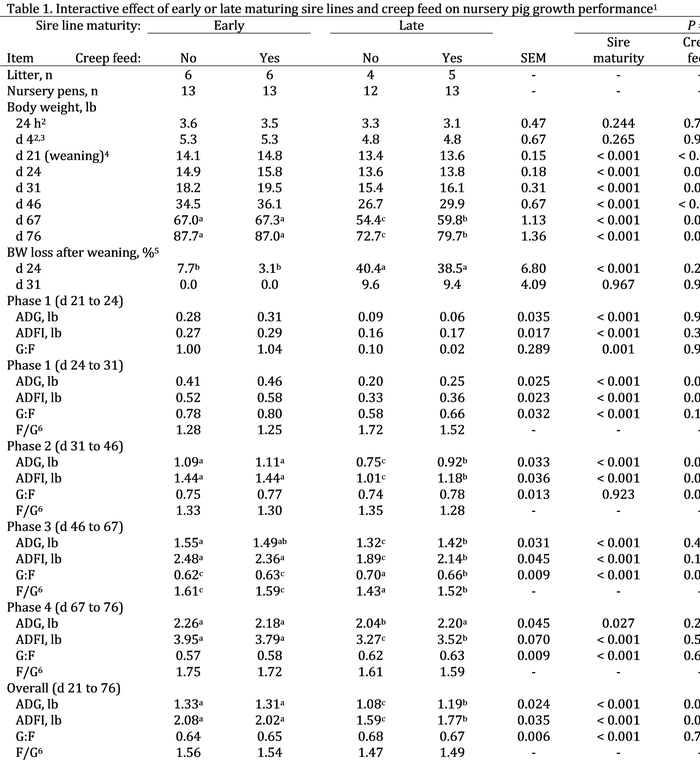
For BW loss after weaning, no differences were observed for the two-way interaction or main effect of creep feed. However, a greater percentage of late maturing pigs lost weight during the first 3 d in the nursery (21 to 24 d of age) compared to early maturing pigs. Likewise, early maturing pigs had improved ADG, ADFI and feed efficiency during the first 3 d in the nursery. Interestingly, creep feeding had no effect on growth performance until after the first 3 d in the nursery. For daily feed intake, early maturing pigs had increased daily feed intake (sire maturity × day) for the first 14 d in the nursery compared to late maturing pigs (Figure 1), which could explain the initial improvement in growth performance and decreased percentage of pigs that lost weight after weaning.
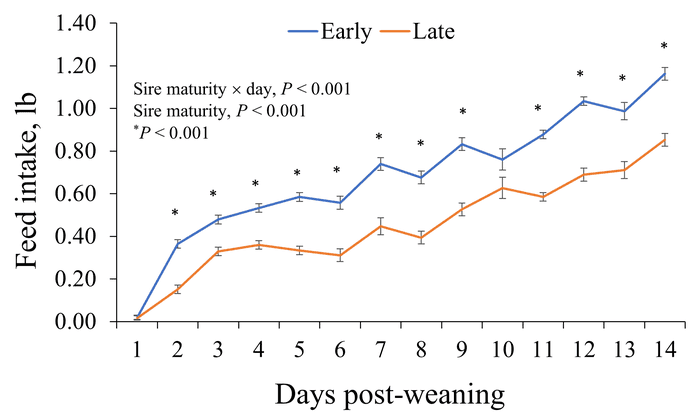
During the grow-finish period, early maturing pigs continued to have increased ADG compared to late maturing pigs until d 94. Similar growth was observed from d 94 to 136, or approximately 220 lb, at which point the late maturing pigs began to exhibit increased ADG. Late maturing pigs also had improved F/G throughout most of the finishing period. Overall, a significant interaction was observed for ADG, with late maturing pigs that received creep feed prior to weaning having increased ADG compared to the other three treatment combinations. A significant interaction was also observed for ADFI, with late maturing pigs that received creep feed or early maturing pigs that received creep feed or not having increased ADFI compared to late maturing pigs that did not receive creep feed. This resulted in a significant interaction for final BW, with late maturing pigs that did not receive creep feed having decreased weights at market compared to the other three treatment combinations. To visually summarize the modeled ADG and F/G curves can be found in Figures 2 and 3.
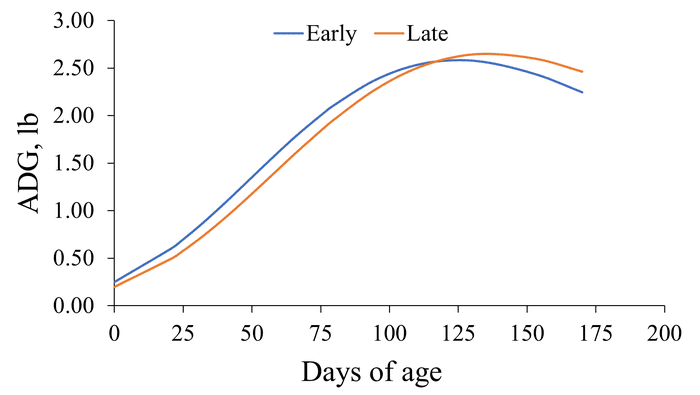
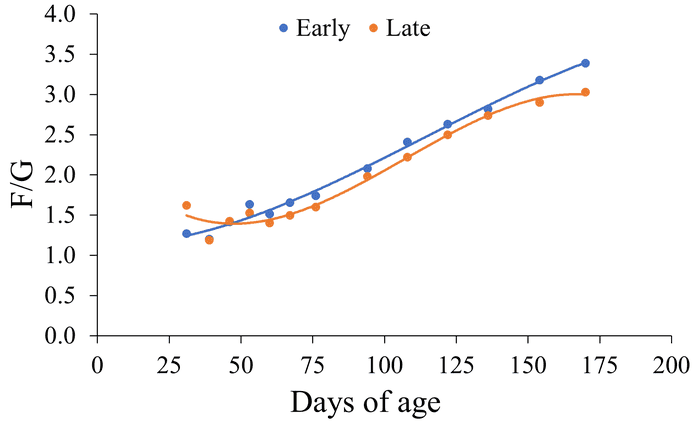
For carcass characteristics, no differences in hot carcass weight or backfat were observed. Increased yield was observed for pigs that received creep feed prior to weaning compared to pigs that did not receive creep feed. A two-way interaction was also observed for loin depth, with pigs from the early maturing sires that did not receive creep feed having decreased loin depth compared to the other three treatment combinations. For the main effect of sire line, late maturing pigs had increased percent lean and loin depth compared to early maturing pigs.
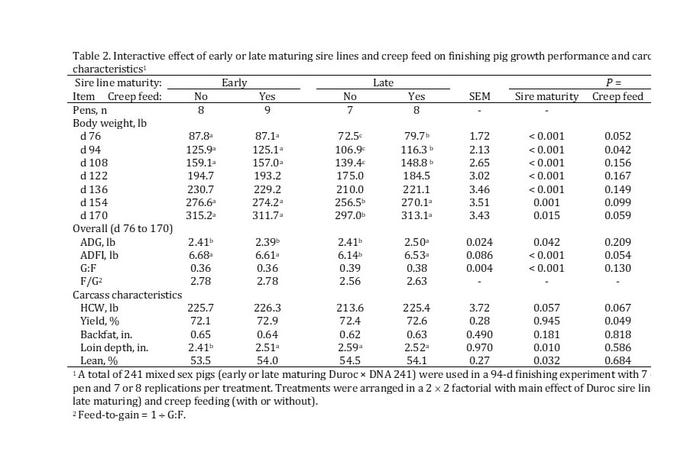
For blood cortisol, no three-way or two-way interaction between creep feed and collection day, or the main effect of creep feed were observed. However, a significant sire line maturity and collection day interaction was observed. Baseline (pre-wean) cortisol levels were approximately 30 ng/mL for both sire lines, but 30 minutes after weaning a greater increase in blood cortisol was observed in late maturing pigs compared to early maturing pigs. For intestinal permeability, no two-way interactions or main effects were observed for lactulose, mannitol or the L:M ratio (Table 3). However, numeric differences did exist. Late maturing pigs that were not provided creep feed prior to weaning had the highest L:M ratio. An increased L:M ratio indicates increased intestinal permeability and may be related to the poorer growth performance observed in late maturing pigs that were not provided creep feed. More research and a greater sample size is needed to better understand this potential effect.
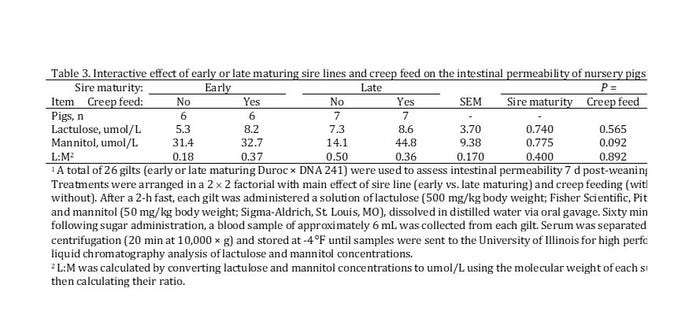
In summary, early maturing pigs exhibited decreased stress and improved growth performance immediately after weaning. Improved BW gain and feed intake persisted until approximately 220 lb or 136 d of age, at which point late maturing pigs began to exhibit greater ADG. Late maturing pigs also had improved feed efficiency throughout much of the experiment. Interestingly, it appears that creep feeding the late maturing pigs resulted in improved growth performance compared to providing no creep feed, whereas creep feed had little impact on early maturing pigs.
For more details, please find the full journal article here.
You May Also Like
.png?width=300&auto=webp&quality=80&disable=upscale)

